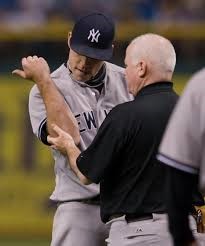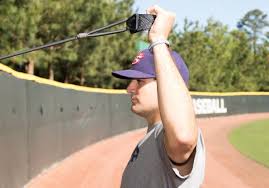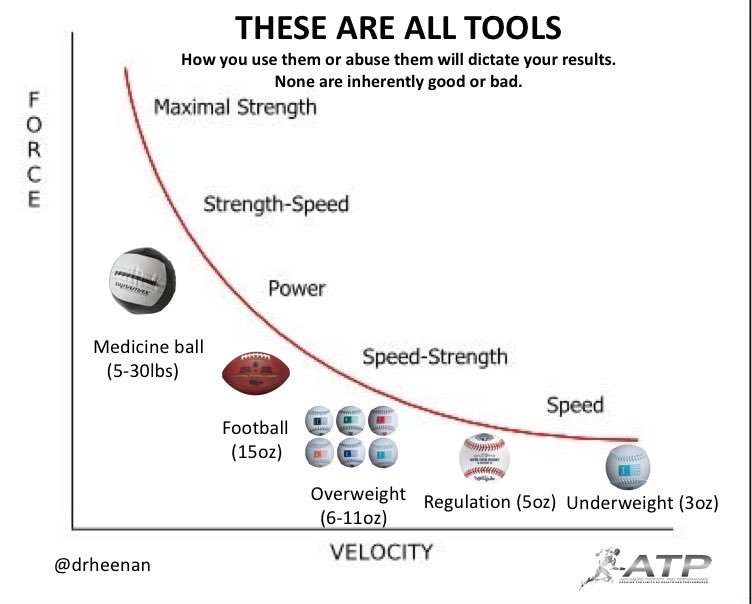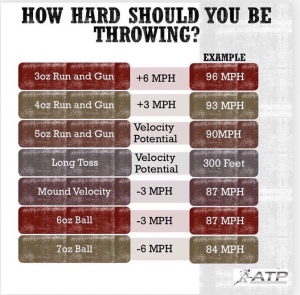If you have been a pitcher for an extended period of time you understand the aches and pains that come with it. Good mechanics or not, everyone at some point has or will experience some kind of issue. Bicep tendinitis, rotator cuff weakness, elbow stiffness…
In my early teenage days, I had doctors often suggest the R.I.C.E Protocol: Rest Ice, Compression, and Elevation. When tendinitis was the issue, it definitely helped decrease inflammation and made it easier to throw again. Sometimes it worked after a week, sometimes it worked after a month, likely treating the symptoms rather than the cause. No matter what, the hardest part was the return to action and increasing throwing intensity.
Part of the grind is building up arm strength again, but the true battle was the mental block of throwing the ball progressively harder. The school of thought for me was to start playing catch. Every few days increase the distance by 10 feet or so, ultimately getting to the point of long-tossing and hopefully without any pain or the symptoms that were happening with the arm injury.
Past my college career I started to ponder on this way of thinking. Was I rehabbing my injury correctly? Was the return to throwing really that strategic or was I just hoping that every day throwing would feel better?
First thing is first that no rehab program should be “cookie cut.” While there is some value in progressing distance and throwing intensity, I think that we can approach things a little bit better.
For starters, I think that every pitcher dealing with an injury has to begin with assessments. What has the doctor/ physical therapist diagnosed as the injury and what are the limitations? What are the ranges of motion available and what kind of muscle imbalances are present with the athlete?

On top of a physical screening, I think that a biomechanical analysis can tell us even more. Using film of this particular athlete, what kind of positions is this pitcher in with his delivery?

How much external rotation is he getting into and what valgus forces appear to be taking place? With this kind of evaluation, we might be able to connect the dots to the site of injury.
If we have a specific pitcher experiencing bicep tendinitis, we may find his delivery to be putting him in excessive shoulder horizontal abduction upon front foot strike. If this pitcher is experiencing tightness in his elbow, does he show poor scapular loading in mid-stride of his delivery? Perhaps his rotator cuff is showing signs of weakness and/or instability and doesn’t have efficient mechanics to reduce stress in the elbow.
We have to identify the flaws in every aspect of throwing and build a foundation from that. Once we can optimize the function of the throwing arm we can then progress towards mechanical adjustments to reduce the chances of re-injuring the same area of the body. In some instances, another area of the arm can begin to hurt over time. Ever had an elbow injury and eventually had it creep up to somewhere in the shoulder? Maybe the inverse of that?
A common thing that I see in most pitchers is poor scapular mobility and control. As a baseball pitcher, it is not uncommon to see excessive tightness on the front side and weakness in the back. Think about the throwing motion as an overhead athlete. We take the shoulder into external rotation and absorb a lot of force in each throw, especially when our front foot hits the ground on a downhill slope.
On another note with the scapula (the shoulder blade), it is also common to see anatomical abnormalities in overhead athletes. Depending on what muscles are overactive, the scapula on the throwing side can sit in different angles and positions at the individual’s “normal posture.”  This is something that can be fixed through Corrective Exercise and should be a focus in any pitcher’s throwing program. (Make sure to check out the next blog on the scapula in baseball athletes.)
This is something that can be fixed through Corrective Exercise and should be a focus in any pitcher’s throwing program. (Make sure to check out the next blog on the scapula in baseball athletes.)
Nonetheless most rehab exercises focus on back and rotator cuff strengthening because the rear muscles work as our decelerators. Think of it like the brakes of your arm, if they aren’t working the shoulder would continue moving in the direction of the arm action… forward.
The reason why scapular mobility and control is important is because it plays a major role in how efficiently we move through each throw. The better we use the big muscles of our back the less the smaller muscles/tendons have to work. That includes forearm muscles, triceps, biceps, and rotator cuff (subscapularis, supraspinatus, infraspinatus, and teres minor/major).
That includes forearm muscles, triceps, biceps, and rotator cuff (subscapularis, supraspinatus, infraspinatus, and teres minor/major).
The more we rely on the little muscles the more likely that they will wear out. When we get into a better scapular load, we use muscles like our rhomboids and latissumus dorsi. Like Eric Cressey says, we ask a lot out of our little muscles when we ask them to do “big boy things.”
In my opinion, the best way to train the big muscles of the throwing arm is to place a fair amount of eccentric loading in a throwing program. In terms of throwing mechanics, the eccentric portion is when we go from thoracic extension into arm acceleration, and through the release of the baseball (reaching out in front).

While we can make the argument that simply throwing more often will train these muscles, we can also be reinforcing the poor movement patterns that have caused the injury in the first place.
This where a basic rotator cuff strengthening program can be not enough. Yes we can improve the strength and stability of the shoulder joint,  but only training with basic rotator cuff band exercises won’t place enough stress on the bigger muscles.
but only training with basic rotator cuff band exercises won’t place enough stress on the bigger muscles.
This is where weighted balls can provide a major impact in a throwing program. While there is a case to be made that weighted balls can increase the risk of injury, I think that is only when we do not follow a strategic progression for how we use them. In reality, higher velocity, poor mechanics and overload are the higher likely cause of most pitching injuries.
And to not be forgotten, we have to have adequate upper body strength before we emphasize speed/power and implement training with a loaded throwing motion.

Nonetheless we have established that we first have to identify a pitchers anatomy and correct muscle imbalances. We have to increase the strength of both our smaller and bigger muscle groups, and we have to improve a throwing motion before we increase intensity. So how do we progress?
For starters, I think that deceleration work can be accomplished through various drills using weighted balls. Tom House talks about how he studied the kinematics of a tennis serve in comparison to a baseball throw. The one key difference that he noticed was how tennis players hold on to their racket in deceleration, as in opposition a pitcher releases the ball.
If we go through similar movement patterns holding a weighted ball, with correct mechanics we can train the “big boy muscles” to decelerate. Like anything strength training, progressive overload is what ultimately creates muscle adaptation to get stronger through a trained range of motion.
That means that we begin with a load similar to or at a 5 oz baseball. Through several weeks of a weighted ball program, we can gradually increase to something like a 32 oz ball. The progression of weight increase is subjective to the individual because there are so many factors that determine their capacity. For most adolescent pitchers, they may not have the strength and proper motor control to go through such drills with that much weight. Maybe a 15 oz ball can be the heaviest they can handle.
And let’s say for a high school senior or college pitcher who has undergone some kind of strength training program, they may have the adequate strength and skills that would make it appropriate to use a 32 oz ball or heavier. It depends solely on how well they can perform the drill and how they respond.
Once we establish our ability to decelerate at a high capacity, we can go back down in weight of the weighted balls and begin to actually throw them. We follow the same progression model and work our way towards throwing heavier balls with more intensity or volume.
As for using these methods for a return to throwing program in a rehab setting, the details of progression have to be that much more finely tuned. If the throwing athlete experiences quick fatigue, then we have to take a more conservative approach and take our time. If the athlete is responding well and is feeling stronger, then we can be more aggressive by increasing the intensity of the drill work. Regardless if we are holding onto the ball or releasing it.
Intensity can be measured through various parameters. Increasing the weight of the ball is a given, but we can also track things velocity and Rate of Perceived Exertion (RPE). If throwing a 7 oz ball at 50 MPH feels good, then we can progress towards attempting to throw it at 55 MPH. Then 60, then 65, and so on until the program feels right to progress towards throwing a heavier ball. How often we increase intensity is subjective, but ideally we wouldn’t increase a whole lot in one throwing/ drill work session. Progressions should be gradual in terms of days and weeks. If we overload too quickly, we can set the athlete up for setbacks with muscular and neural fatigue.
If we reach that threshold using a 7 oz with a specific velocity and intensity, then we know that it is safe to progress to another scale in the weighted ball program. We work our way up until we know that we are ready to advance to the next portion of our throwing program… pitching.

As for RPE, we rely on the individual athlete’s perception of intensity from a 1-10 scale (weighted ball or regular 5 oz). Until we know for sure that we can throw the specific ball at 100% or more of our known capacity, we stick with the phase we’re in until we are ready to progress. There is some research on using appropriate percentages of progression based off what that individual can throw a regular 5 oz baseball in MPH.

If we reach that threshold using a 7 oz with a specific velocity and intensity, then we know that it is safe to progress to another scale in the weighted ball program. We work our way up until we know that we are ready to advance to the next portion of our throwing program… pitching.
It is no secret that I am a big fan of weighted balls and also understand that it is not for everyone. In spite of this I think that every pitcher can benefit from some kind of overload/ underload training. You don’t always have to throw a weighted ball and can always benefit from other training approaches like Corrective Exercise and Strength training.
In my professional opinion, we have to always rely on Anatomy and Physics to improve throwing performance. The throwing motion of a baseball athlete has a dynamic movement pattern that can have an infinite combination of flaws. We have to understand that no matter what we do with a baseball we are training. If we rely solely on throwing a regulation 5 oz ball, the movement patterns will have little to no change over time.
I think that the best approach is to assess the individual and provide corrective work to ensure proper function. Once we can achieve optimal range of motion and function, we can then seek to optimize performance. This can take us down many paths with training and throwing programs, so it is imperative that we seek the best approach possible while taking all of these things into account.





Leave a comment